Defective aircraft carriers are not suitable for the Russian fleet
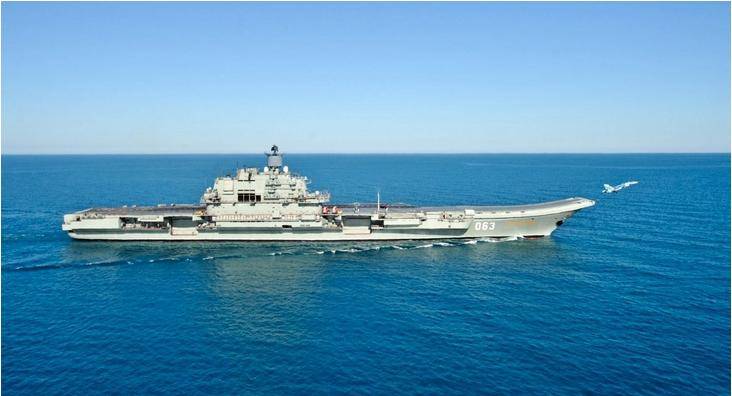
In the short term, there is no alternative to Kuznetsov
Study of what really can be light aircraft carriers and aircraft with short / vertical take-off and landingof that how much do they end up being cheaper for societies that already have at least some carrier forces and carrier-based (in Russian terminology - ship) aviationand that how much can an aircraft carrier replace a landing ship with a through flight deck (at least easy and inferior), it was necessary not by itself. It was needed to assess which direction the Russian fleet is heading towards the development of carrier forces, and now they are trying to push it (the other). And I must say that it's not all simple.
Options for Russia
According to “The Fundamentals of State Policy of the Russian Federation in the Field of Naval Activities for the Period Until 2030”approved by presidential decree No. 327 of July 20, 2017, it is planned to create an offshore aircraft carrier complex in Russia.
What is this complex, the question is still open. The Navy wants a large aircraft carrier, and the Navy is right about this. It is possible that a tactical and technical task for such a ship or TTZ project has already been formulated somewhere. However, there are nuances.
The practice of naval construction in recent years in Russia shows that often scientifically sound decisions, or even just already launched and practically feasible projects, are simply destroyed by the personal will of individual figures influential enough to overturn the normal decision-making process with a “kick”, contrasting the established order with personal incompetence due to the position of power and corruption interest at the same time. This is how project 20386 came about, which destroyed the ability to renew domestic anti-submarine forces in a reasonable amount of time, so project 22160 appeared, which the fleet now simply does not know where to stick, and this is useless vessel (just like that) in the end, it just defiles from one base to another.
Could something like this happen to future carrier forces? Alas, yes.
two news for thought.
The first one already appeared in the very first article on the topic: "According to Deputy Prime Minister Yuri Borisov, a vertical take-off and landing aircraft is being developed in Russia.".
Second: on December 2, 2019, President Putin at a meeting on the problems of military shipbuilding stated:
I must say that with all due respect to the personality of V.V. It is impossible not to miss Putin, that achieving dominance at sea and in the air is a prerequisite for the use of landing ships and landing as such. And this outside the base combat radius aviation can only be achieved with the help of naval aviation. However, the "Fundamentals", according to which we should still have aircraft carriers, he approved.
However, individuals “several levels lower” may have their own interest.
Before the fire on the aircraft carrier Admiral Kuznetsov, the author was hinted that he might not get out of the repair. Moreover, in the testimony of people who survived the flooding of the PD-50 floating dock, there is such an interesting thing as the “strong push” that people on the floating dock felt before it began to flood.
Then the fire that happened “out of the blue”. This is some kind of strange chain of coincidences, as if they are pushing us somewhere.
The British, too, had a similar fire, to the Victories AB, which was quite moderate in its consequences, but after it the government of Harold Wilson, who was eager to turn the third most powerful country in the world into the hand-held dog of the Americans, was written off by this aircraft carrier, although he still could serve. Has our Wilson started somewhere, even in a low position?
Let’s go on the other side. In 2005, a number of specialists from GOSNII AS wrote a book “Aviation of the Russian Navy and scientific and technological progress. Concepts of creation, development paths, research methodology ”. This work, saturated with both interesting facts and a curious hardware, contains one interesting statement. The authors point out that every time the scientific research on aircraft carrier topics was intensified in the USSR, in the West, in the specialized press, there was just a shaft of publications that painted in paints how wonderful light aircraft carriers are, how much they give to those countries that have them are invested, and that, generally speaking, is the future main route for the development of aircraft carrier forces.
True, the Nimitse appeared on the output, then the Fords, and in the worst case Charles de Gaulle and Queen Elizabeth.
The fact that in Russia there is a lobby, albeit weak (and hidden), puzzled by the issues of depriving our country of at least some significant aircraft carrier forces, will be unobvious for many, but it does exist, and there is information support for the idea of “let's write off Kuznetsov” and instead we will build a pair of UDC with “vertical lines”, too, there is - otherwise it simply could not have spread so widely.
Here is a banal example of another idea that was propagated by the same methods.
There is an opinion, and this opinion has a lot of supporters that atomic submarines armed with anti-ship missiles (SSGN) are such a superweapon that can literally sweep out any number of aircraft carrier groups from the face of the oceans. Apologists for this idea think that they themselves have come to this, or appeal to the time of S.G. Gorshkova when such submarines "registered" in the Navy.
In fact, in the Soviet Navy, these ships were part of a very complex system, from which there is almost nothing left today, and the very concept of “PLARK as a superweapon” was very competently thrown into the unstable consciousness of Russian patriots by a concrete Russian-speaking resident of the city of Seattle, never a Russian citizen being at the turn of the 2000s and 2010s. At the same time, a person works for himself in the American aviation industry and has good communications in the US Navy. Why he did this is still an open question. We won’t poke a finger, just, if you are a supporter of this idea, then keep in mind that in fact it is not yours.
It is also possible to accurately track the source of the set of ideas “why do we need an aircraft carrier, because you can put a dozen VTOL aircraft on a landing ship, here’s your aircraft carrier,” if you ask yourself. Such ideas simply do not arise.
Thus, we have a complex of the following events:
- from somewhere in the mass consciousness the idea of using landing ships instead of aircraft carriers and vertical / short take-off and vertical landing aircraft instead of normal ones made their way into the mass consciousness;
- it seems that some kind of the same idea was thrown to the very top, in any case, Y. Borisov claims that the creation of the SKVVP is carried out “on the instructions of the president”;
- the only aircraft carrier and the infrastructure for its repair is pursued by a sequence of accidents and disasters, which in some places look somewhat strange and make you think about sabotage;
- the president announced that destroyers and landing ships will be the basis of Russia's sea power.
All these factors taken together indicate that the distortion of the development path of domestic aircraft carrier forces and the repetition of British mistakes by our country is quite real. And the fact that Russia is supposedly being pushed according to the British version is also significant in many respects.
So far, it is known that the “development” of the SKVVP does not really really go well: this is not an experimental development (OCD), the result of which should be a real plane. This is a research work - R&D, and it is still very far from OCD. Both the fleet and the VKS take off this aircraft as soon as they can, and the reasons for this are quite obvious, because it will be as worse than domestic aircraft with normal take-offs and landings, as the Sea Harrier was worse than the Phantom for the British Navy. It remains only to wish success to sailors and pilots in the disruption of this undertaking, this project really will not be of any use.
And it’s worthwhile to finish off the idea of the usefulness of a hypothetical domestic “vertical line” completely.
Vertical thrust versus horizontal speed
You need to understand that there is never enough money, and directing financing to one project it is impossible not to cut funding to another project. When sending money to SEC, it is necessary to understand where they will be taken from. And to be sure that it will be justified. And you also need to understand the time factor.
How much money and time will be spent on creating a hypothetical domestic SKVVP? So far it has taken two years. Already. And some money too. Fortunately, we have the opportunity to make a forecast, focusing, firstly, on how many such planes are created in modern Russia, and, secondly, on how much time it took to create them before.
The closest in complexity to the hypothetical SKVVP is the PAK FA / Su-57 program. Briefly go over it. First about time.
The creation of the fifth generation fighter started in 1986. Now it’s 2020, and the plane is still not ready - there is no full-time engine, there are questions about the radar with AFAR. All this will also be solved, but not today, but within a few years. If we assume that in 2024 we will have in the series a fighter with a second stage engine and more or less localized serial H036 radar, then we can say that for 38 years the task of creating a new generation aircraft was completed.
Briefly go over the stages: MiG 1.42 and 1.44, projects of the Sukhoi Design Bureau S-37 and later S-47 "Golden Eagle", the work of the Design Bureau named after The cradles above the engines that generated the AL-41F, together with the never-built Mikoyan LFI and S-54 from Sukhoi, made up the scientific and technical groundwork necessary for the design and construction of the fighter. In the early 2000s, those OCD started, which eventually spawned the Su-57 and would soon spawn its full-time engine and radar. Without the previous array of work on experimental combat aircraft and engines for them, the PAK FA program would not have started.
Thus, to create a fundamentally new car, our country needs 35-40 years.
And if you count from the start of the PAK FA program, without taking into account the time spent on the previous backlog, then the countdown should be from 2001. That is, today it is 19 years old, and for our hypothetical 2024 - 23.
But maybe there is an opportunity to somehow resolve the issue more quickly? Let's look at how these issues were resolved before.
So, our first serial vertically flying attack aircraft, which was truly combat-ready, was the Yak-38M of 1984. A little-known fact - in terms of its qualities in percussion operations, this machine surpassed the Harriers and lost the first place among the verticals only in 1987, with the advent of the Harrier II.
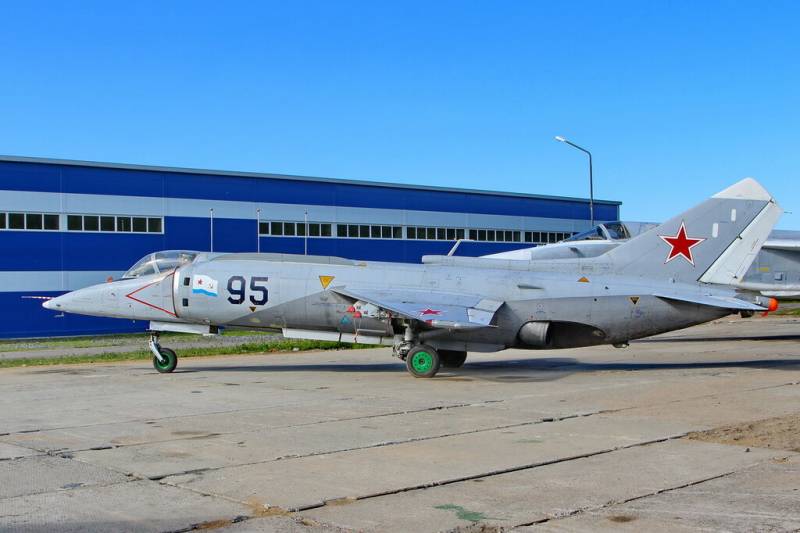
Option “M” and “clean” Yak-38, many consider the same aircraft, but this was far from the case. In the photo, the color version characteristic of the latest serial Yak-38M
Of course, in terms of its flight-technical characteristics, the Yak was much inferior to normal aircraft, but it was absolutely inevitable, the Harrier was also worse than the Phantoms, and the F-35B was significantly worse than the F-35C.
How long did it take Yakovlev Design Bureau, the Navy and the USSR as a whole to finally create a normal combat VTOL? We look at the stages:
1960-1967: the Yak-36 project, a stillborn demonstrator of the possibility of vertical take-off, which, however, had a fatal effect on naval aviation and the navy on the brain of D.F. Ustinova.
1967-1984: the epic with the first serial "vertical" - the Yak-36M / 38. This car was created for three years, then for seven years it went to a series, after entering service, it turned out that the planes were not operational, they had to be redone at first, sometimes directly on the ships, this did not help, in 1980 they were sent to the war in Afghanistan, where it was possible to choose the optimal settings for the engines and nozzles during take-off. After that, the aircraft quickly reached the limit of their combat effectiveness and showed that they could not fight, after which the following modification was created, which became more or less combat ready.
Total: 24 years to the first serial finished attack aircraft. What about the Yak-41? He was prevented by the collapse of the USSR, but before the collapse of the USSR, they were engaged in this machine since 1974 (the first drawings began to be drawn even earlier). Thus, 17 years passed from the political decision to create an aircraft to the start of its tests - and all this was before the collapse of the USSR. Then the Americans paid for several more years of testing and the construction of two more prototypes, and even this was not enough to at least approach the real capabilities of this machine. For today, there is documentation and one sample suitable as a guide. He is being dragged now through workshops and laboratories as part of ongoing research.
Thus, in the USSR, the timing of the creation of military aircraft was not much shorter. But maybe it is we Russians who are so blue-legged, and we need to learn something in the West? Also no. At Harrier (if you count with Kestrel, which is inseparable from the final machine), the path from drawing to commissioning took 12 years from 1957 (the beginning of work on Kestrel) to 1969 (the first production Harriers in the Air Force). At the same time, this aircraft had avionics at the Stone Age level, and later it was necessary to develop its marine modification, which also cost time and money. If the British took Kestrel from the start as a sea plane, at 12 they would not have been able to meet it.

Hero Falkland began in the era of black and white photo
A more recent example is the American Joint Strike Fighter program, which spawned the F-35. It began back in 1993, and she had previous studies. Only 13 years later, the F-35 was selected as the winner in the competition, but only in 2015 the first air force unit on these machines reached combat readiness, and the first F-35B air defense systems reached combat readiness only in 2018.
These are the real deadlines for creating new aircraft today.
How much does it cost in money? Leave America and focus on our financial realities. It is still known that about 57 billion rubles were spent on the Su-60. But, firstly, in this amount there is not a penny from the period 1986-2001, there are no expenses for the creation of NTZ, and there are only two flying aircraft in it, one MiG and one Su. Secondly, the various associated OCD, which were funded by the Ministry of Industry and Trade, were not taken into account. Today, we, apparently, can confidently say that the creation of a fundamentally new machine on the existing NTZ (let, for example, materials on the Yak-41/141 and “Product 201” be considered NTZ), can cost about 70-80 billion rubles. If it turns out that the existing NTZ is not sufficient (and this is already so in fact - otherwise, “on the instructions of the president”, the ROC would immediately begin to create the “vertical line”, but R&D would begin), then the amount should be increased, the terms too.
Let's just say - really, if you push hard and invest serious resources, get a ready SKVVP by 2040. Naturally, we are talking only about the first flying prototype.
But by the time the fifth generation is already obsolete. Today it is not clear exactly what the 6th generation fighter will be, while a number of domestic experts believe that it is impossible to realize the transition to a new level of combat capabilities, while remaining within the same machine and we should talk about a system of various manned and unmanned vehicles operating jointly. How to enter here the work on the new “vertical” is an open question, but the fact that the transition to the next generation is not cheap and more important than the “vertical” can be considered accomplished.
The conclusion from all this is simple: if now we “turn off the path” that our country embarked on in 1982, that is, from the path of creating full-fledged carrier forces, with normal aircraft carriers and planes with horizontal take-off and landing, then to create only one plane with with short or vertical take-off and vertical landing, it will take us at least 80 billion rubles and at least 20 years of time - and this is only up to the first prototypes, not up to the series.
And if you do not collapse? And if you do not turn off, then we suddenly find that the ship (deck) fighter in our series. It's about the MiG-29K.
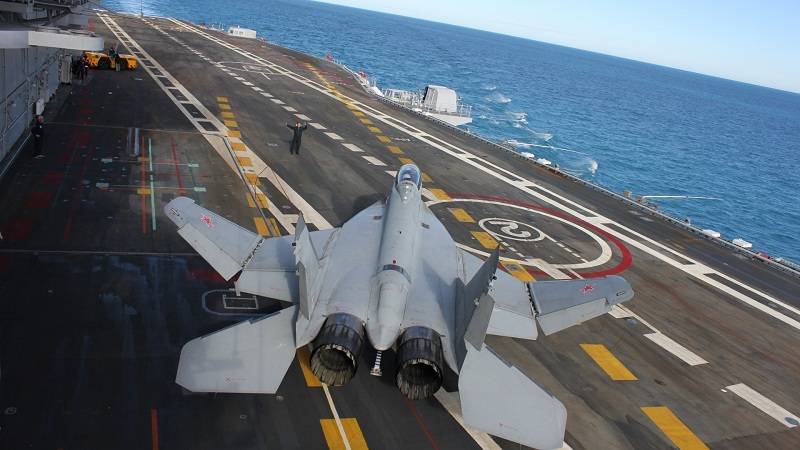
In our country, a fully-fledged multi-functional ship fighter is mass-produced. In the photo - MiG-29K on the deck of the aircraft carrier "Vikramaditya" Indian Navy
At the mention of this plane, some start to frown, but let's call a spade a spade - this is a GOOD plane. Moreover, it is in service not only in our fleet, but also in the Indian Navy - and not the fact that the Indians will not buy it yet. And this despite the fact that they already have more MiGs than ours. But they have a choice.
What are its disadvantages? There are basically three of them.
The first is the old radar. Even the latest version of the Zhuk radar with AFAR does not fully satisfy the requirements of a modern war. The second problem is high landing speed. It is known that our pilots-decks even observed detachment of the retina from overload during landing. I must say that this is abnormal, this should not happen, and not only because of humanism, but also because it imposes restrictions on the maximum number of landings per day for an individual pilot and limits the possibilities for combat training.
The last problem is the long and laborious inter-flight service.
Potentially, in the future, if or when it comes to creating a catapult aircraft carrier, you will need a modification with a reinforced bow and a front landing gear that can withstand a catapult launch.
What do we have in this way?
Firstly, the plane is already there. We do not need 20 years of time and 80 billion money to create it. Secondly, the example of the F-35C, for which the Americans developed a new wing to improve landing characteristics, shows that the problem of high landing speed is solvable. Moreover, the Americans decided it in 4 years - just so much later relative to the machine for the Air Force deck option "C" came into operation.
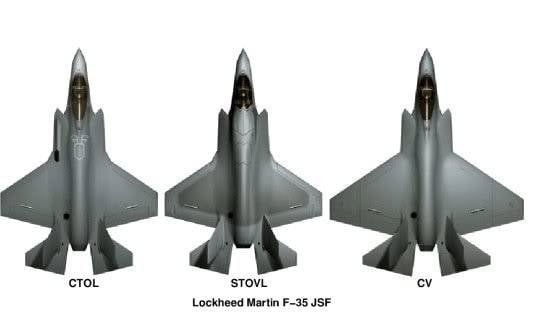
Differences between the wings of the F-35C from other aircraft options.
Actually, when modifications to an airplane are limited to a glider, they usually last several years — the Chinese made their decked aircraft under an ejection launch in about the same time frame and they are now flying from their ground experimental catapults.
The problem of radar with AFAR can also be solved in five or six years, if you deal with it: at least, they have finally started investing in this issue. That is, a new radar may well appear on the new MiG, moreover, over the same five to six years. All this, of course, will also require money and time - but incomparably less than a fundamentally new aircraft, and most importantly - we repeat - there is no need to wait for new aircraft until there is a “new MiG” that can be dispensed with by those that are and are produced in series.
The service problem looks difficult to solve - but even our MiG is much better than the F-35 in this parameter, and secondly, the severity of this problem can be reduced to some extent on future modifications, although it will not be completely solved.
Thus, in terms of aircraft, Russia faces a choice of two ways.
First: to use a production car, which is in service with the fleets of the two countries, was used once in military operations, has a double combat training option, which is not very bad by any standards, although it does not reach the F-35C, and as soon as finances allow , make a new modification, which will be created in about 5 years.
Second: to invest fantastic money in the “vertical” project, which with a 100% probability will have no better avionics than other domestic aircraft by the time they are ready, will lag behind the West as much as our conventional planes, and all this for the sake of so that in twenty or more years of hard work we get an airplane inferior to what we can have a maximum of five years from now.
Common sense tells us that there really is no choice here, and those who try to present the matter in such a way that it does exist, commit treason or stupidity, looking at whom they are talking about.
For technological and financial reasons, the bet on serial equipment for us so far has no alternative character.
From which the second conclusion follows - the bet on an existing aircraft carrier, too, so far has no alternative character.
Kuznetsov and our near future
The propaganda of ideas such as “Aircraft carriers are outdated” and “Russia doesn’t need an aircraft carrier”, which was absolutely distraught by heat, has already dealt so hard a blow to the minds of our people that the fact of having an aircraft carrier in our fleet simply fell out of mass consciousness. The frenzied propaganda of the futility of American aircraft carriers played a cruel joke with us - our people are now confident in the futility of this class of ships in general, and the result was that the future of now Russian aircraft carriers has come into question. Our propaganda is indifferent to the Americans. Many people in Russia simply don’t remember that we, generally speaking, HAVE aircraft carrier forces, consisting of one aircraft carrier and two (!) Aviation regiments.
Another thing is that they are not operational. But for now.
Generally speaking, it is worth remembering that the first landing of a ship’s aircraft on a ship in our country was in 1972, the first combat use of ship’s ground attack aircraft in combat was 1980, and in the same year the Tavkr with Yaks was used to pressure a foreign country - successfully. It’s also worth remembering that at the time of the collapse of the USSR, the number of aircraft-carrying ships in our country was as follows: 4 in service, 1 in testing, and 2 in construction, which made our aircraft carrier firmly second in the world after the United States, there are no Britain and France nearby did not stand in those years.
If NATO is dropped, then five countries have Eurasia - two in China, one in service and one in completion in India, one in Russia and one in Thailand. The USSR or Russia was related to all of them, except for the Thai "Shakri Narubet." Our Kuznetsov and Chinese Liaoning are Soviet sisterships, Shandong is a further development of what is called the Kuznetsov-class in the West, Vikramadis is a former Baku / Admiral Gorshkov rebuilt already in post-Soviet Russia , and the Nevsky Design Bureau took an active part in the creation of the Indian Wikrant.
All Indian carrier-based combat aircraft made in our country, and the Chinese are the development of the Su-33.
Some, as many people think, “alien” to Russia in relation to aircraft carriers and carrier-based aircraft is just a hassle that has been induced from the outside, and nothing more. It is necessary to reset it already.
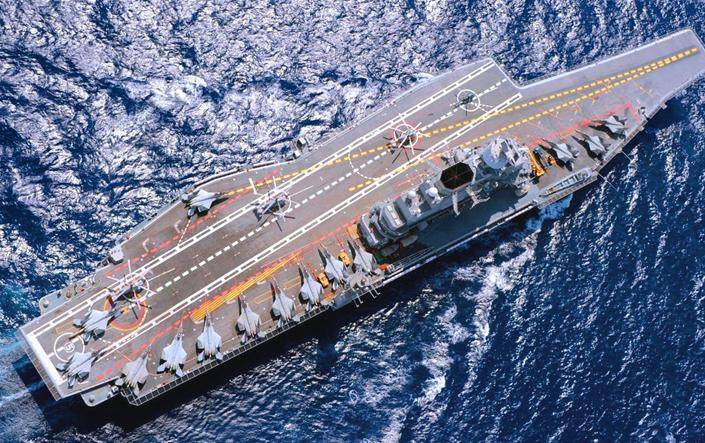
The pride of the Indian Navy is the Vikramaditya aircraft carrier, built in the USSR, rebuilt as an aircraft carrier in Russia, and Russian-made carrier-based fighter aircraft. But we still "don’t know how to be an aircraft carrier," of course, yes?
The fact that against such a background there are individuals who are quite seriously arguing that “aircraft carriers are not for us” and other similar things, looks strange for a healthy person.
Let's get back to reality.
Aircraft carriers become obsolete only when aviation becomes obsolete and not earlier. An aircraft carrier is an aerodrome for airplanes that can ensure their deployment where ground airfields are too far away. No nearby airfields? Need an aircraft carrier. Do you want to have an aircraft carrier? Refuse national interests where you do not have airfields NEAR.
And if there are not “interests” there, but rather real threats, then REFUSE THE NEUTRALIZATION OF THESE THREATS.
There are no other options and do not try to come up with them.
It’s almost impossible to fight without aviation even in very wild countries - at least if we have in mind the war with some sane goals, deadlines and reasonable losses. And airfields are far from everywhere.
These issues were discussed in more detail in the articles. “Coast Defense Carrier” и “Carrier issue. The fire at Kuznetsovo and the possible future of aircraft carriers in the Russian Federation ”. The first of them reflects the early views of the command of the Navy of the USSR and Russia on the use of aircraft carriers in the country's defense, the second reveals their importance in the current political situation, and at the same time describes in detail how to deal with Kuznetsov so that it becomes truly useful for the country ship, from changing approaches to combat training to improvement. And this is exactly what needs to be done first. It is such a set of measures that should be the first step towards the revival (namely, the revival, and not the creation!) Of our carrier forces.
What's next? Next - build a new one. The bigger, the better. And here it is worth listening to the senior command staff of the Navy. Usually criticized (for the cause) in the case of aircraft carriers, our admirals responsible for shipbuilding are more right than ever.
Here is what, for example, the former deputy said. Navy Commander-in-Chief for Arms Vice Admiral V.I. Bursuk before his resignation:
Neither add nor take away. The larger the ship, the stronger its air group, the less it depends on the unrest at sea, the less accidents it has when moving planes on the deck and in the hangar, the easier it is for pilots to conduct combat work.
What if for organizational reasons such ships cannot be built? Then it is possible to study the issue of building an aircraft carrier in a class similar to the Indian Wickrant or French Charles de Gaulle, but with an important caveat - if you can create a ship with seaworthiness at least at the Kuznetsov level with less displacement. Approaches to this task were described in the article. “Aircraft carrier for Russia. Faster than you expect. ”.
And there is a clearly stipulated condition - if calculations and experiments on models show that it is not possible to provide the necessary seaworthiness on such a ship, then there are no options left, it is impossible to build such ships, and our country will have to take the “aircraft carrier barrier” for real.
This will not be the most difficult barrier that we took, even close, you just need to get together and do it. And this will not be the most costly of our barriers, we have mastered more expensive events, and not so long ago.
Financial issue
The last myth left to debunk is that by betting on using “large” UDCs or light aircraft carriers as carriers, you can save at least on ships.
For an adequate assessment of investments, one thing must be clearly understood - we are not interested in the ship itself, but in what it gives. For example, for a URO ship, its missile salvo is important. And for the carrier forces, it is important how many sorties they can provide in a TOTAL unit per time. Roughly speaking, we are not buying an aircraft carrier or aircraft carriers, but plane departures per hour, taking into account the unrest at sea.
So, for example, the same Falklands showed that for light British aircraft carriers and their planes even 20 sorties per day is almost an unattainable value. That means the hundreds of millions (billions at current prices) of pounds that the British cost to build three defective Invincible ships, they could provide a theoretical limit of 60 sorties per day for a short period of time, but rather 45-51.
First, we will estimate how many sorties can be provided by our current aircraft carrier, which we use as a “starting point” - Kuznetsov.
Unfortunately, in practice, our naval aviation did not fly at maximum takeoff and landing performance - we simply never had the right number of pilots who could fly from the deck. Before the Syrian campaign, the situation began to be rectified - the deployment of the 100th okiap began, but neither he nor the naval aviation, which had previously been in the naval aviation of the 279th, had reached the Syrian operation, and the aircraft carrier, which had already overdue all conceivable repair terms, was even less ready for a real war. As, however, and his crew.
But all this is fixable, if you work, and there is hope that when the ship nevertheless goes out of repair, naval aviation will be able to rehabilitate itself. In the meantime, we have a theory.
First, we will take it for granted that, due to the need not to exceed the physical load on pilots, and also because of the need to provide inter-flight service to the entire air group in cramped ship conditions, we cannot provide more than two flights per day. In fact, two is not the limit, but for now we use this assumption.
Kuznetsov's hangar makes it easy to place up to 24 MiG-29s and several helicopters of the search and rescue service, apparently 6.
The deck of the ship allows you to place on it up to 13 combat aircraft of the Su-33 type, in the case of MiGs, most likely, it will be the same. We can assume that the deck allows you to hold up to 12 MiGs and one or two MSS helicopters on it.
A logical approach is obtained in which the maximum number of combat groups sent “in one lift” is 12 aircraft. Relatively speaking, we place on the deck 1 "strike" as the Americans say, out of 12 cars, refueled and suspended weapons, in the hangar - the second, all served, just without fuel and weapons.
Then comes the rise of the first group into the air.
How long does it take?
Setting the aircraft to the starting position with well-trained personnel is unlikely to differ from the speed with which the Americans roll their planes on a catapult, that is, about 4 minutes on average. But there is some opportunity to accelerate.
The fact is that when lifting a group to strike, at least the first three aircraft can take off “conveyor” - three cars are at the starting positions, and three more behind the lifted gas bumpers with engines already running. In this case, the first three starts, for example, with an interval of 30 seconds between the planes, which gives us three planes in the air in the first 1,5 minutes, for the next two we get those who stood behind the gas strippers, this is another 2 minutes for all three cars , plus another one and a half for take-off of the second three, so after 5 minutes we have 6 aircraft in the air, and taking into account the required 4 to roll out the first aircraft to launch, we get 6 cars in 9 minutes.
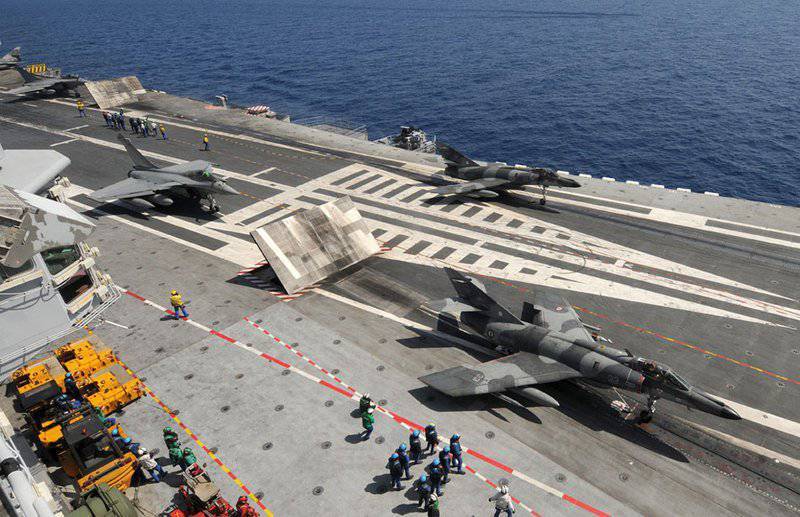
Placing the next in line for the start of aircraft for gas strippers
Then the situation becomes more complicated - you can no longer keep the queue behind the gas chambers, there are already airplanes in the air, if necessary, to ensure an emergency landing, you need to clear the landing zone on the deck as quickly as possible, so the planes will be fed to the launch from the technical positions and after taking off the first two triples we have 4 minutes to exit to the starting position for each troika and 1,5 minutes to take off. Total 5,5. Since our battle group is 12 cars, and the first two triples are already in the air, the other two will take off in 11 minutes. Plus to the first nine we have 20 minutes for 12 cars. After that, they must be "reduced" in the air into a single system and sent to the target. Suppose this takes another 10 minutes.
Total half an hour.
How much time will it take for the aircraft to complete a combat mission? If you don’t fall into fanaticism and act like Americans, then for the maximum allowable combat radius in a real war, you can take 500-550 kilometers. Suppose that the aircraft will fly to the target at a speed of 850 km / h, and will perform the same flight at the same speed. Then the group will return in about 1 hour and 20 minutes. Then she will need to be put on the deck. Thus, the aircraft carrier’s crew will have about 1 hour and 20 minutes to send the second group to strike. Adding here the 10 minutes that the group gathered in the air, we get an hour and a half.
Of these, 20 minutes the second group will need to take off after refueling and suspension of weapons, respectively, to rise from the hangar 12 aircraft, their placement on deck, refueling and suspension of weapons is 1 hour and 10 minutes.
Kuznetsov has two lifts, each of which can simultaneously lift 2 aircraft. At the same time, it is not required to occupy them at the moment of lifting the air group, so the rise of the first four planes from the hangar can be carried out while preparing for the take-off of the first group. Then the lifts are blocked, the planes just stand.
Accordingly, after taking off the last aircraft in the first group, 4 aircraft from the next group will already be on deck, and another 8 in the hangar. Refueling and suspending weapons for four aircraft, and raising eight more from the hangar (these are two lifting and lowering aircraft), which also need to be refueled and armed, do not look unrealistic in one hour, although they go “butt”, like in general, as a whole, takeoff according to the described scheme.
In total, at the maximum pace, in 1 hour 40 minutes you can try to raise 24 cars for a strike, provided that they were prepared for the departure in advance, half were in technical positions, refueling and with suspended weapons, and of the remaining 4 cars were on locked lifts , four more in the hangar ready to be served on the lifts, four behind them, the ASP are ready to be served on the deck.
Immediately after this, the landing of the first group should begin, its placement in technical positions, fuel drain, removal of unused weapons, and cleaning of aircraft in the hangar. For this, the crew of the ship will have the same hour and a half. Is it real?
Watch the landing animation. The man who made this video, many years ago, participated in the creation of domestic ship planes for Kuznetsov.
The video shows landing of 9 aircraft, but the deck is not empty, one of the starting positions is occupied by a fighter ready for take-off, one technical position is also occupied, and stops on the lifts are not made. Theoretically, there is no reason to believe that 12 cars cannot be put on a completely empty deck in the same mode. To land them at a 60-second interval, thus, it will take about 12 minutes without taking into account the time of approach to the glide path of the first aircraft and without taking into account possible misses by the cable or cable breaks.
At the same time, the impact on a 550-kilometer radius in theory leaves enough fuel to fit the entire group, although also without special reserves. On the other hand, we make an approximate estimate “on the fingers”, and if later it turns out that for the declared number of air groups the exact combat radius should be no more than 450 km, then this makes little difference.
Thus, after landing the first group, the crew will be required to drain fuel from the aircraft in about an hour and 18 minutes, remove unused TSA, and in groups of 4 cars lower the aircraft into the hangar, and then immediately proceed to take the next air group.
What does this indicative estimate show? It shows that when flying out to strike with large forces, the maximum number of strike groups will be about 12 vehicles. If it’s less, then not by much, most likely not less than 10. And in half a day the ship will easily send into battle and take back two such groups, that is, almost all of its aircraft. Taking as a limit two sorties per day per pilot, we get approximately 48 sorties per day, two per plane. It looks quite realistic.
Of course, when performing air defense tasks, or when working in small groups, on 2-4 aircraft, or in any other circumstances, the statistics will be different.
For example, the possibility of an almost continuous ascent of the entire air group while working on a short combat radius is theoretically justified, although this is possible only when deviating from the current safety standards, for example, while in the hangar there will inevitably be refueling aircraft with suspended weapons, and the lifts will work in the moment of aircraft lifting into the air.
In addition, there will be no way to quickly interrupt the take-off of an air group if a plane that previously took off suddenly needs a landing, for example, due to a technical malfunction. But we know an approximate figure for a landmark - 48 sorties a day. If the pilot can be sent into battle three times with a knock, then more, but this is already under serious question.
Why do we need this criterion?
Then, what if we theorize about new aircraft carriers, then their ability to raise aircraft should not be less.
And also because it is important for us not only to know with what capacity a ship can provide aircraft lift, we also need to understand the relationship between the capabilities of promising ships and their costs. How many sorties per day for a billion rubles can we do with one or another development option of the Russian aircraft carrier forces, that’s what’s important.
And here the supporters of the concept of "UDC instead of an aircraft carrier" will have to "make room" a lot.
First about the prices.
How much can one really save on UDC or a similarly sized vertical carrier carrier if you build it, and not an aircraft carrier?
Let's compare.
Imagine that the Navy built something like the Italian “Kavur” - 10 VTOL aircraft in a hangar, you can optionally carry it (instead of aviation) Tanks, a little less than 30 kilotons of displacement. To the Italians such a ship stood at a little over 1,5 billion dollars. We, taking into account the fact that we can not buy components on the world market, will get up at about 2.
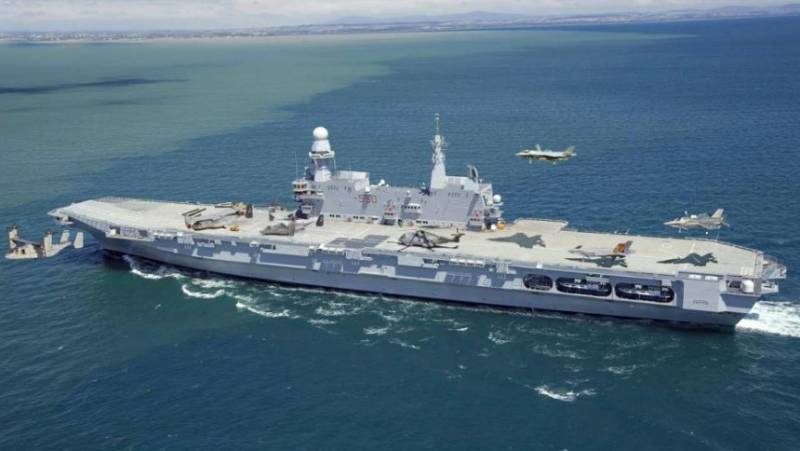
Station wagon. And an aircraft carrier for 10 aircraft, and a helicopter carrier for a battalion of lightly armed assault troops, and a carrier of two boats for a foot landing company and a ferry for transporting equipment from port to port. It remains only to imagine a war where exactly this is needed
Well, or 140 billion rubles. This is quite logical, because the “small” UDCs of project 23900 that are unable to carry aircraft will cost about “from 50 billion”, and for them most likely there is a ready-made power plant, electronic weapons there will be many times easier and much more.
What do we have for 140 billion? Assuming that our “vertical” will be able to perform the same number of sorties per day as the MiG-29K from Kuznetsov, we get about 20 sorties.
But Kuznetsov has 48. We need something comparable. Therefore, we must build another “Russian Cavour”. And now we have the opportunity to complete 40 sorties. For 280 billion rubles.
However, here it is also necessary to add the cost of OCD for airplanes, because the development of vertical lines costs money. Accordingly, another 280 billion is added to 80 billion, and roundly our project rises to us 360 billion.
But the trouble is the price of a catapult aircraft carrier. With the same air group as Kuznetsov’s, with the same range in terms of sorties (approximately), under an upgraded serial fighter, but — attention — with the possibility in the future to place on it AWACS aircraft, even Chinese, purchased, and made on their basis transport aircraft.
As a result, for the same money we get opportunities that are never realized at Russian Cavour, and potentially, albeit not a big, but real superiority in the number of sorties per day.
After that, the differences begin. For a catapult aircraft carrier, we need one crew, and for two “Kavuros” two are almost the same. This is money.
The infrastructure for basing is needed in double size, the tankers for providing fuel - in double size, and this is also money. Tanker - 3-4 billion minimum. Take it out.
At the same time, the technical risks of the second option are unbelievable, the aircraft may not work out, and it may take a long time to lay down ships until it can fly.
And wait 20 years, if not more.
But you can look at the situation differently.
Suppose, in Russia, they built a 70000-ton nuclear carrier for, for example, 500 billion rubles - as objects for the Sochi Olympics. Did the Olympics in Sochi bust you?
What will the fleet get in terms of the number of departures from such a ship? Based on the Americans, one can say that 100-120 a day without tension, since there will be more air groups than 24 aircraft.
How many “Russian Kavurov” do we need to work out the same way? Five six.
And this is already in the money 700-840 billion for the ships themselves and 80 for the creation of a missile defense system. Almost a trillion. And then the difference will begin to pile up on crews, moorings, supply tankers and everything else. For the same effect that one large ship will give.
And much more severe weather restrictions - remember about small ships on the pitching.
In general, everything is like the English - one to one. It makes no difference, right up to the fire on the aircraft carrier being repaired. We just need to do something different from what they did at one time. We need to do the opposite.
Conclusion
At present, our carrier forces, consisting of an aircraft carrier cruiser (in fact it’s been an aircraft carrier for a long time, the Granites can’t fly from this ship for a long time, and they don’t need it on it) the Admiral Kuznetsov, as well as the 100th and 279th separate naval aviation regiments are not combat ready. The regiments have insufficient training and have not yet reached the required level of combat readiness, and the ship is under repair, complicated by the unavailability of the dock necessary for its completion.
Nevertheless, this state of affairs is far from catastrophic - no later than 2025 the aircraft carrier will be back in service, and regiments, if the information on organizational conclusions following the results of the Syrian operation is correct, will be more or less able to carry out their mission.
The starting point in the further evolution of these forces should be to bring Kuznetsov, its crew and the aircraft operating from it to the maximum possible combat readiness. In addition, the problem of basing both this ship and the air regiments must finally be solved, since Severomorsk-3 is absolutely unsuitable as a base for ship (deck) aviation.
In the future, it is necessary to find opportunities to implement the provisions of the "Fundamentals of the state policy of the Russian Federation in the field of naval activities for the period until 2030" regarding the creation of a marine aircraft carrier complex. Although the development of such has not even begun yet, but if you focus on the statements of Vice Admiral Bursuk and other senior naval officers responsible for shipbuilding, then this should be a large ship with a nuclear power plant.
In case the creation of such a ship is not possible in the foreseeable future, it is worth exploring the possibility of building an aircraft carrier with a gas turbine power plant, and a displacement of 40 thousand tons, but only on the condition that it is possible to come up with such a hull form that would ensure acceptable seaworthiness for such a ship.
Otherwise, it makes no sense to build it and in any case, you need to look for the opportunity to get a normal ship for the fleet - right up to its joint construction with another country.
And here are ideas that are actively being promoted now in the press that UDC can be used instead of an aircraft carrier, that you can quickly create a plane with short or vertical take-off and vertical landing and replace normal aircraft carrier forces with an ersatz from a landing ship and air defense missile system, or even limit yourself Helicopters are malicious. Moreover, there are examples when in the past such ideas were deliberately thrown from abroad. The fact that neither the Navy nor the VKS do not feel any enthusiasm for research on the subject of SQUWP is very indicative - they simply do not need it. And it’s not necessary not because they don’t understand something, but because it really isn’t necessary.
Taking into account the fact that behind the idea of replacing an aircraft carrier with a UDC, with which horribly individual figures in the "near fleet" begin to loom, it is worthwhile to once again focus on the fact that our country does not need defective aircraft carriers and their similarities for a lot of money. Our country needs a moderate-priced fleet with maximum return on every ruble invested.
And normal aircraft carrier forces in the long run meet this requirement much better than crazy projects of aircraft with obscure prospects and "ships for the poor."
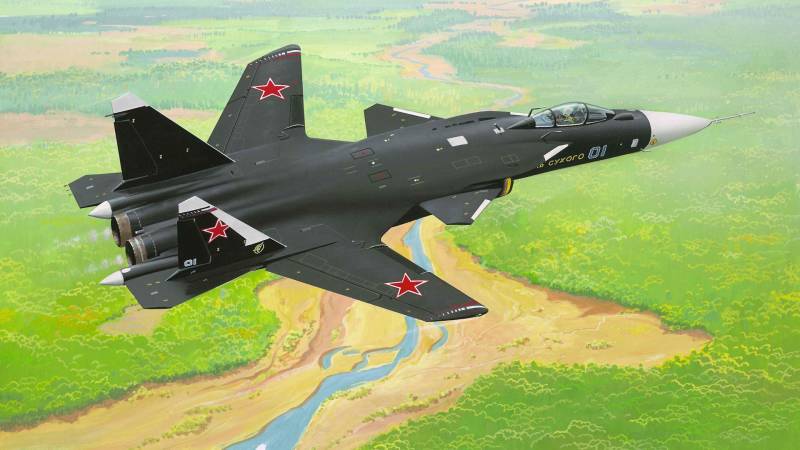
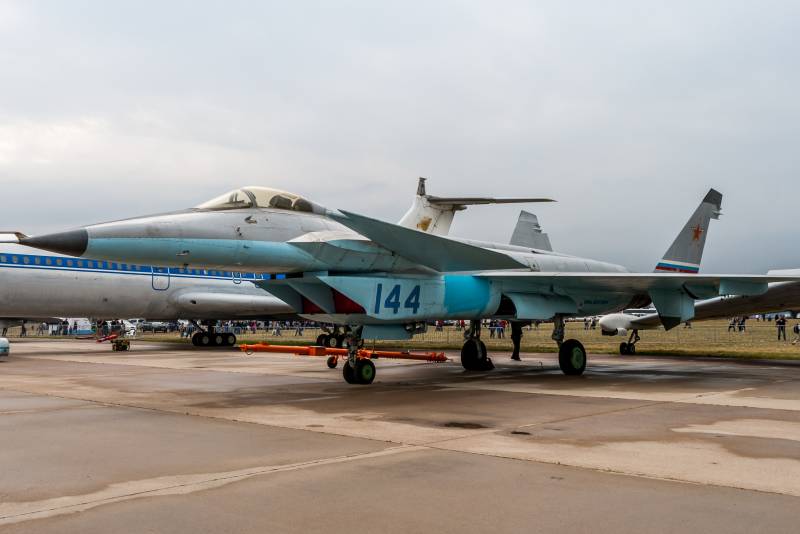
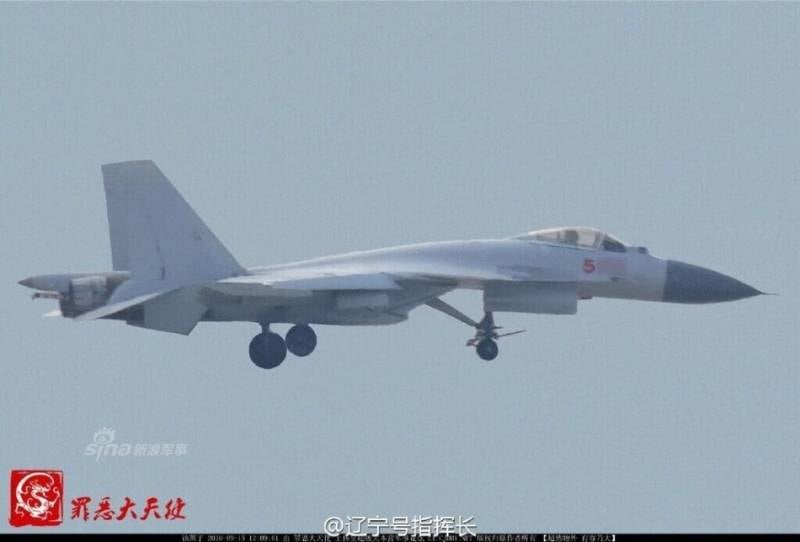
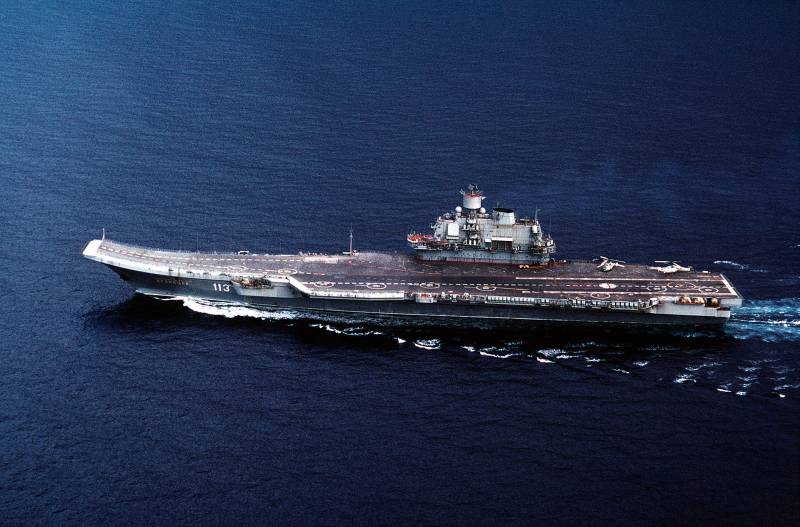
Information